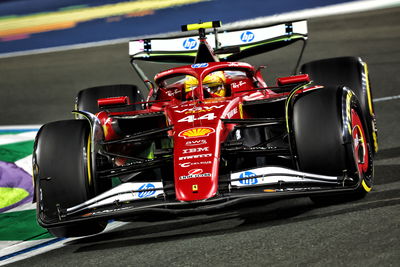The ‘whole world of change’ Mercedes is wary of being “tripped up” by in F1 2021

Formula 1 teams are facing a unique challenge in 2021, and the incoming changes - small as they might seem - pose a threat to Mercedes’ stronghold at the top of the sport.
While teams will carry over their 2020 chassis into the new season as part of a cost-saving measure with a technical regulation overhaul now delayed until 2022 in the wake of the coronavirus pandemic, some pretty big changes will still be made to this year’s cars.
There had been concern that unrestricted aerodynamic development of the cars would result in even bigger lap time gains, and as a result, greater stresses being forced onto Pirelli’s tyres, with F1 cars already dealing the tyres with the biggest forces ever experienced - leading to several dramatic blow-ups at last year’s British Grand Prix.
The potential for a further speed increase, coupled with a 5kg rise in minimum weight for the cars and power units to 150kg, ultimately prompted the decision to cut downforce levels by around 10 percent for the upcoming 2021 season.
It has left teams with an unusual and unfamiliar winter of development. Despite avoiding the typical huge production effort of making an entirely new chassis, the development focus has instead been on adapting to the aero tweaks.
Such a change in philosophy and rhythm has been a “weird” adjustment for teams to get used to, as well as providing them with a complex and difficult challenge, according to Mercedes technical director James Allison.
“Probably the most intense and difficult thing for us is reacting to the aerodynamic changes that come for 2021,” explained Allison.
“There was a concern that if we left the aerodynamic development of these cars unchecked then the performance would just keep increasing as it has been doing it for a number of seasons now.
“It would keep increasing to a level where the cars would just simply outgrow the tyres and perhaps even aspects of the circuits.
“So, there was a good need to bring the performance down a bit from the cars so that they would be able to go into the new season if 2021 with the mechanical packages designed for 2020, remember, and be confident that the performance of the car would be matched to the physical infrastructure that the car was built around.”
Visually, the changes may not be hugely noticeable to the untrained eye, but F1 fans will be able to spot alterations to the floor shape of this year’s cars, as well as further minor changes made to the rear brake duct winglets, which will be slightly reduced in height.
Allison believes that four key aero changes have created Mercedes’ “most intense and difficult” challenge yet and will add up to a significant cut in downforce and trim performance down to 2019 levels.
“There has been a triangular cut-out to the edges of the floor in front of the rear wheels which when you see it you’ll think ‘that doesn't look that big’ but on its own, in its rawest form if you just chop that area off your car it’ll take about a second a lap away from the car,” he said.
“The first was that the little fins and flicks that were on the rear brake duct were reduced in their span just by a few millimetres but again they were very powerful devices and that change lost a lot of performance from the car.
“At the back of the car underneath in the diffuser area the fences that you can see if you peer up the backend of the car, they were reduced in height so that they can't go as near to the ground, they can't create as good of an aerodynamic seal to the ground as they did previously.
“And again, they shed a bunch of downforce when they are trimmed upwards. And then finally the front-end of the floor as you approach where the bargeboards are if you looked at the 2020 versions of those floors you see that they look a bit like a venetian blind with lots and lots of slots, an aerodynamic feature there that generates downforce and all of those slots have been removed for 2021.
“The combination of those four effects in their rawest form just cut-off and trim back in a way that the rules require brings the performance of the car way back to sort of somewhere near 2019 levels,” Allison added.
“It's been our challenge over the weeks since those rules, the weeks, and months those rules were set in stone to try to recover as much of the performance as possible. That has been quite an entertaining ride in the wind tunnel and in CFD to try and make sure that we get that performance as far as possible back onto the car.”
In an attempt to make F1’s tyres more robust and durable, Pirelli is introducing a new construction for 2021 which makes a set of tyres around 3kg heavier, adding yet another variable into the equation for the teams.
"We got a first glimpse of these new tyres back in Portimão in 2020,” Allison said. “We’ve had two other occasions where we could test them, and they were in Bahrain and then in Abu Dhabi the last race of last year.
"That's not really very much opportunity to take on board a new tyre and get ready for a new season with it because these tyres will affect the way that the car performs and they affect the way that you have to design the aerodynamic platform and the way that you have to set up the car.
“So it's been a big challenge for us to try and stretch out that testing data that we had at the tracks last year and to try and make as much as we can out of the tyre data supplied to us by Pirelli so that we would be ready to really optimise the car around the characteristics of these new tyres.”
Additionally, Mercedes will lose its dual-axis steering wheel system (better known as DAS), which has been outlawed from this season, while engine upgrades have been restricted to just one between the end of 2020 and the end of 2021.
This, according to Allison, has provided Mercedes with yet another “significant challenge” and ramped up the pressure on the HPP department to “pile as much goodness into that upgrade as possible and then make it stick because you just get that one shot at it.”
The introduction of a $145m cost cap and new aero handicap rules are set to impact Mercedes' quest to sweep both world championship titles for an eighth consecutive season in 2021.
Allison says the challenge of operating within the boundaries of these changes have kept Mercedes “on our toes for a long, long time”, conceding that the reigning world champion squad is paying the price for its success with less time on the wind tunnel throughout this year.
“There is a whole world of change that has gone on completely separate to that which is every bit as big and which has made the winter and these past months unbelievably hard work,” Allison explained.
“The biggest of these by far is trying to assimilate, to understand and assimilate the new financial regulations, the so-called cost cap regulations, to make sure that we can adapt our organisation to be able to operate within the much tighter confines of this new regulation.
“We have for many years now been limited in the amount that we were allowed to use the wind tunnel and the CFD. The limit in the past has always been the same for all competitors whereas for 2021 that has changed and now we get a different allowance depending on how successful we were in the previous season.
“Basically the last-placed team in 2020 is allowed their wind tunnel about 20 percent more than the first-placed team and everyone in between is on a sliding scale between that 20 percent and what the first-placed team gets.
“We were lucky enough to be good last year and unfortunately, we pay the price for that a little bit in 2021 and beyond because we get to use less of that fundamental asset, the wind tunnel and the CFD computers compared to our competitors.”
Mercedes has subsequently placed emphasis on establishing how it can gain the most from the plethora of new restrictions and regulation changes.
“For us, the challenge has been, how do we react to this new regulation in the most positive way? How can we make sure that we don't get tripped up by it?” Allison said.
“And there the challenge has been if we are not allowed to use as much of our wind tunnel and our CFD as we were previously how could we adapt our world so that we get more and more out of every single opportunity in that wind tunnel?
“So, we’ve tried to adapt our approach to this, so we mitigate and maybe even completely offset the effect of this reduction in the amount that we are allowed to use these fundamental tools.”
Allison warned that people should not be “fooled” into the notion that the competitive order is guaranteed to remain the same in 2021 and result in a repeat of Mercedes’ dominance seen last year.
“The rules are very, very different for 2021,” he added. “The work we've had to do has been very wide-reaching and we hope we have done enough to stay successful.
“But as ever at this time of year, we are just full of the anxiety and excitement of waiting to find out whether all this investment that we have made into the new car will indeed pay off with a challenger that is capable of fighting from the front.”











